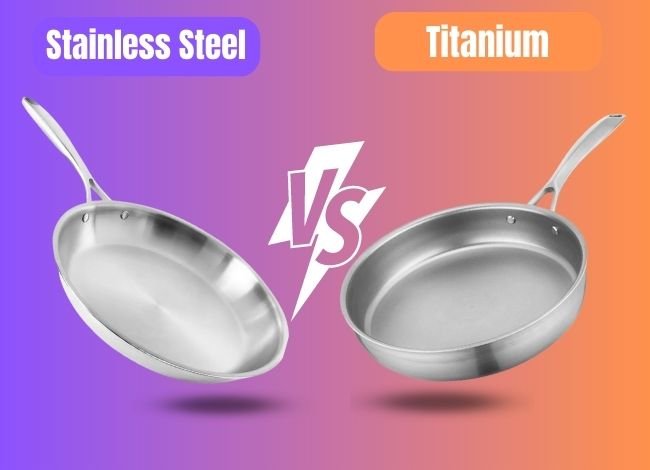Last Updated on January 10, 2024
Titanium and stainless steel cookware are two popular options for modern kitchens, each offering unique features and advantages. To help you make the best choice for your kitchen, this article comprehensively compares titanium and stainless steel cookware, including a comparison table.
Comparison Table:
Feature |
Titanium Cookware |
Stainless Steel Cookware |
|---|---|---|
| Material | Pure titanium or titanium-infused | Steel alloy with chromium and nickel |
| Weight | Lightweight | Heavier than titanium cookware |
| Heat conductivity | Good heat conductivity | Good heat conductivity |
| Heat distribution | Even heat distribution | Even heat distribution |
| Heat responsiveness | Moderate heat responsiveness | Moderate heat responsiveness |
| Reactivity | Non-reactive with acidic foods | Non-reactive with acidic foods |
| Seasoning | Does not require seasoning | Does not require seasoning |
| Non-stick properties | Inherently non-stick or non-stick coating | May require oil or butter for non-stick performance |
| Durability | Highly durable and resistant to scratches | Highly durable and resistant to corrosion |
| Maintenance | Low maintenance and dishwasher safe | Low maintenance and dishwasher safe |
| Price range | Mid-range to premium pricing | Mid-range to premium pricing |
Material: Titanium cookware is made from either pure titanium or titanium-infused materials, providing excellent strength and durability. Stainless steel cookware is made from a steel alloy that includes chromium and nickel, making it resistant to corrosion and staining.
Weight: Titanium cookware is significantly lighter than stainless steel cookware, making it easier to handle and maneuver.
Heat Conductivity: Both titanium and stainless steel cookware have good heat conductivity, ensuring that they heat up quickly and evenly.
Heat Distribution: Titanium and stainless steel cookware provide even heat distribution across the surface, ensuring consistent cooking results.
Heat Responsiveness: Both titanium and stainless steel cookware have moderate heat responsiveness, allowing for some level of temperature control during cooking.
Reactivity: Both titanium and stainless steel cookware are non-reactive with acidic foods, making them suitable for cooking various ingredients without affecting taste or appearance.
Seasoning: Neither titanium nor stainless steel cookware requires seasoning.
Non-stick Properties: Titanium cookware is inherently non-stick or comes with a non-stick coating, making it easy to cook without additional fats or oils. Stainless steel cookware may require oil or butter to prevent food from sticking.
Durability: Titanium cookware is highly durable and resistant to scratches, while stainless steel cookware is highly durable and resistant to corrosion.
Maintenance: Both titanium and stainless steel cookware are low-maintenance and dishwasher safe, making them easy to care for.
Price Range: Titanium and stainless steel cookware typically fall within the mid-range to premium pricing categories.
Conclusion: The choice between titanium and stainless steel cookware depends on your preferences and priorities. Titanium cookware is lightweight, durable, and often has non-stick properties, making it an excellent choice for those who value ease of use and maneuverability. However, it can be more expensive than stainless steel cookware.
Stainless steel cookware is highly durable, resistant to corrosion, and non-reactive, making it a reliable and long-lasting option for home cooks. It may require oil or butter for non-stick performance, but it offers consistent cooking results and even heat distribution.
Both materials provide good heat conductivity and are low-maintenance, making them suitable for various cooking tasks. By considering the factors discussed in this article, you can make an informed decision and select the best cookware option for your kitchen.
In terms of aesthetics, stainless steel cookware often boasts a sleek, modern appearance, making it an attractive addition to any kitchen. Titanium cookware also features a contemporary look, with a distinct metallic shine that sets it apart.
When it comes to cooking performance, both titanium and stainless steel cookware deliver excellent results. Titanium cookware is particularly well-suited for tasks that require lightweight and easy-to-handle pans, such as flipping, tossing, or stir-frying. Stainless steel cookware, while heavier, is versatile and suitable for a wide range of cooking tasks, including simmering, sautéing, and boiling.
In terms of compatibility with various cooktops, both titanium and stainless steel cookware can be used on gas, electric, and glass-ceramic cooktops. However, always check the manufacturer’s guidelines for compatibility with induction cooktops, as not all cookware is designed for use with this type of heat source.
Ultimately, the choice between titanium and stainless steel cookware comes down to personal preferences and cooking needs. By taking into account the factors discussed in this article, you can make an informed decision and invest in the best cookware for your kitchen.
Related Article Link Here:
- Carbon Steel Vs. Stainless Steel Pans: Which Are Better?
- Ceramic vs Stainless Steel Cookware: Which Is Better?
- Aluminum vs Stainless Steel Cookware Guide [Pros & Cons]
- What is the difference between copper and stainless steel pans?
- Choosing Between Nonstick and Stainless Steel Cookware




